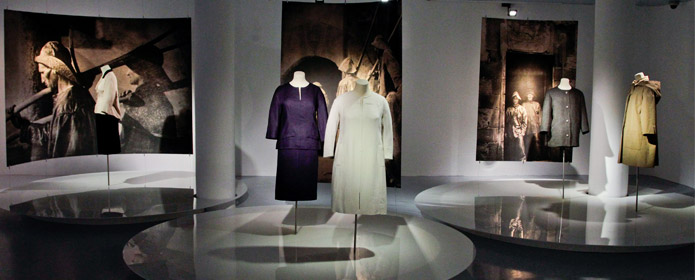The Museum collaborates for the first time with the Cristóbal Balenciaga Museum in a exhibition and lends 17 works of José Ortiz Echagüe
The sample "Charcoal and velvet" offers a dialogue between the couturier's and the photographer's between the creations of the couturier and the photographer on the popular costume.

The Museum collaborates for the first time with the Museo Cristóbal Balenciaga for the exhibition "Charcoal and velvet"This exhibition explores the artistic-documentary vision and the aesthetic revision of popular clothing by José Ortiz Echagüe, in his photographic portraits of traditional Spain, and Cristóbal Balenciaga, in his haute couture creations. For this sample curated by Ana Balda, PhD in Communication from the University of Navarra, the Museum has loaned 17 works from its Collection that will be on view at the Guetaria art center until May 7, 2017.
The exhibition is divided into three rooms in which Balenciaga's costumes dialogue with some photographs by Ortiz Echagüe in the background and reproduced on a large scale. In one of these rooms, the 17 original pieces loaned by the Museum are also on display. The sample presents different parallels and encounters between his works, such as the basic elements of the popular costume (the cape, the cloak and the basquiña), the costume for the work (fishing, and the habit) and the costume for the festival (the April Fair and Easter Week).
Ortiz Echagüe (1886-1980) and Balenciaga (1895-1972) coincided in their artistic beginnings with the rise of the so-called Generation of '98. Those intellectuals wanted to build a more modern Spain but also to recover tradition and start from a return to the origins. The popular costume thus became a symbol of the most authentic Spain and its people, a common topic treated by masters of painting such as Zuloaga and Sorolla, among others. The photographer and the couturier joined this trend and captured this popular costume in their works.
Ortiz Echagüe is one of the leading Spanish photographers of the twentieth century and is one of the first explorers and meticulous portraitists of the reality they observed. Part of the success of his images is due to the developing method he used, direct charcoal on fresson paper. The artist cultivated his work around the popular costume from an artistic point of view, not merely documentary. An engineer by profession, he invested much of his free time in the 1910s and 1920s in taking the photographs of folk costume that were published under degree scroll España. Tipos y trajes in 1930, on sale in the Museum store. "We contemplate a treasure that is fast becoming an art about to disappear. Only photography, with its ease of reproduction, is capable of capturing it before it disappears," explained Ortiz Echagüe himself about the recovery of the folk costume.
The old Photographic Fund of the University began in 1981 with the reception of the bequest of José Ortiz Echagüe. As a result of this first donation, the University gathered different collections and legacies that became the Fund, inaugurated in 1990. The photographs of the bequest of José Ortiz Echagüe include all the thematic groups that the photographer developed in his fruitful career: his first photographs taken in North Africa, and the series that make up his four fundamental books: España tipos y trajes ( 1929), España pueblos y paisajes (1939), España mística ( 1943), and España castillos y alcázares ( 1956), to which should be added the group of family images.
